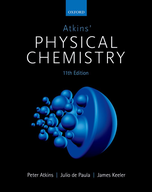?Consider the same situation as in Exercise E10C.4(a). Find the irreducible
Chapter 10, Problem E10C.4(b)(choose chapter or problem)
Consider the same situation as in Exercise E10C.4(a). Find the irreducible representations spanned by the combinations \(\mathrm{p}_{y}(\mathrm{~A})+\mathrm{p}_{y}(\mathrm{~B})\) and \(\mathrm{p}_{y}(\mathrm{~A})-\mathrm{p}_{y}(\mathrm{~B})\). Are there any valence orbitals of the central O atom that can have a non-zero overlap with these combinations of F orbitals?
Text Transcription:
p_yA+p_yB
p_yA-p_yB
Unfortunately, we don't have that question answered yet. But you can get it answered in just 5 hours by Logging in or Becoming a subscriber.
Becoming a subscriber
Or look for another answer
